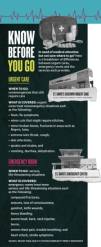The Texas Health and Human Services Commission reports more than 200 freestanding ERs operate in Texas today, and new legislation aims to close the knowledge gap between patients and medical providers as well as hold independent and hospital-affiliated freestanding ERs to the same legal standard as hospital ERs.
The 86th Texas Legislature approved two pieces of legislation related to all freestanding ERs operating in Texas. Senate Bill 1264, which was officially enacted Jan. 1, prohibits health care providers from sending hefty medical bills to insured Texans who sought emergency medical care. Under the new legislation, medical providers and insurance companies are to enter into arbitration and negotiate payment before billing the patient.
House Bill 2041, which was introduced by state Rep. Tom Oliverson, R-Cypress, and went into effect Sept. 1, 2019, pertains to enhancing transparency on in-network and out-of-network ER facilities as well as providing patients disclosure statements on facility fees.
Rhonda Sandel, president of the Texas Association of Freestanding Emergency Centers, said she worked closely with Oliverson on HB 2041 and sees the legislation as an opportunity for independent freestanding ERs to operate in line with hospitals. The legislation, Sandel said, updates chapter 254 of Texas’ Health and Safety Code, with independent freestanding ERs now reporting their data just as hospitals do in an effort to increase transparency notices.
Independent freestanding ERs and hospital-affiliated freestanding ERs function virtually the same for the patient, Sandel said. The main difference between the two, Sandel said, comes down to ownership: Independent freestanding ERs can be owned by physicians or a corporation, while hospital-affiliated freestanding ERs are owned directly by a hospital.
“We have always argued and agreed that we need to be treated just like the hospital-based ERs are to prevent patients’ confusion,” Sandel said. “We requested legislation; we wanted transparency; we worked with Dr. Oliverson on this bill; and we agreed with it. We wanted it so that we could see and we would be on a level playing field with the hospitals.”
Texas Hospital Association could not be reached immediately for comment on recent legislation regarding surprise medical billing.
Nurse and patient perspectives
Jaime Simon has been a registered nurse for 19 years and first began her career in the ER at St. David’s Round Rock Medical Center. As a freestanding ER nurse for the past five years, Simon said these facilities have given her increased flexibility in her own work schedule, ensuring ER workers are not overtired or working through breaks.
Simon also added an important component to freestanding ERs is that they take some of the burden off traditional hospital ERs, allowing her to treat more patients in a shorter period of time.
“The volume at freestandings is much less, so we get to cater to our patients,” Simon said.
Patsy Bradford, a Pflugerville resident, said now that the city has its Baylor Scott & White Medical Center with an attached ER, she does not see the value of visiting a freestanding ER—especially if patients have to be transported to a hospital in an emergency anyway.
Miriam Moorman, also of Pflugerville, said her reservation about freestanding emergency rooms comes from the potential costs affiliated with visits along with whether insurance companies are in-network and will provide coverage for an ER visit.
“Who, in an emergency, is going to be calling their insurance company to see where they can go?” Moorman said. “People who need and deserve medical care may end up with bills that are more damaging to them than the medical condition for which they were treated.”
Increasing accessibility
Sandel said some of the negative connotations affiliated with independent freestanding ERs have extended from patients’ complaints filed against hospital-affiliated ERs. She said her concern with some of the ways in which freestanding ERs have been presented, both in the media and in the Legislature, could impact patients’ willingness to seek treatment for potentially serious health complications.
“Our goal is to be advocates for patients and to provide quality health care and make sure that there’s access for all,” Sandel said. “And there should not be any regulation driven by insurance companies or otherwise that prohibits access to health care, and emergency health care at that.”
Following introduction of his bill, SB 1264, in 2019, state Sen. Kelly Hancock, R-North Richland Hills, said his bill would help remove patients from billing disputes between insurance providers and health care agencies, according to an Apr. 16 article by The Texas Tribune.
Christina Rose, a Hutto resident, said she has visited both First Choice Emergency Room in Pflugerville and Five Star ER in Hutto. One of the biggest misconceptions patients might have with ERs, Rose said, is conflating them with urgent care facilities.
Urgent care facilities are similar to a traditional doctor’s visit, just with longer hours and weekend openings, Sandel said. Urgent cares typically treat more minor ailments that are not life-threatening but need to receive medical treatment.
“I know a lot of people go [to emergency rooms] for things that aren’t necessarily emergencies, but maybe they aren’t aware that there’s an urgent care that they can go to,” Rose said. “The more people that come in that have an issue that’s greater than yours, the longer you’re going to sit and wait.”
Following her freestanding ER visit, Rose said staff walked her through how the billing process would work as well as how to challenge any potential claim by her insurance company that it was out-of-network and not covered by her insurance plan.
Sandel said as SB 1264 goes into effect and prohibits surprise medical billing, it is important for there to be increased transparency among insurance providers to protect patients’ right to access emergency medical care in potentially serious situations.







